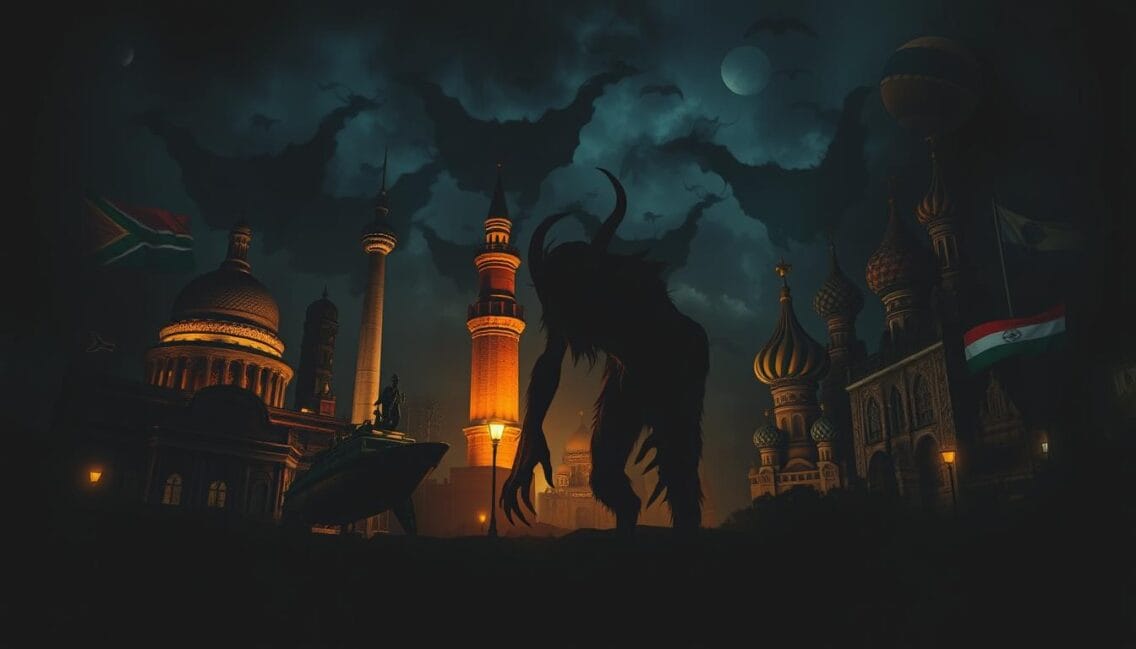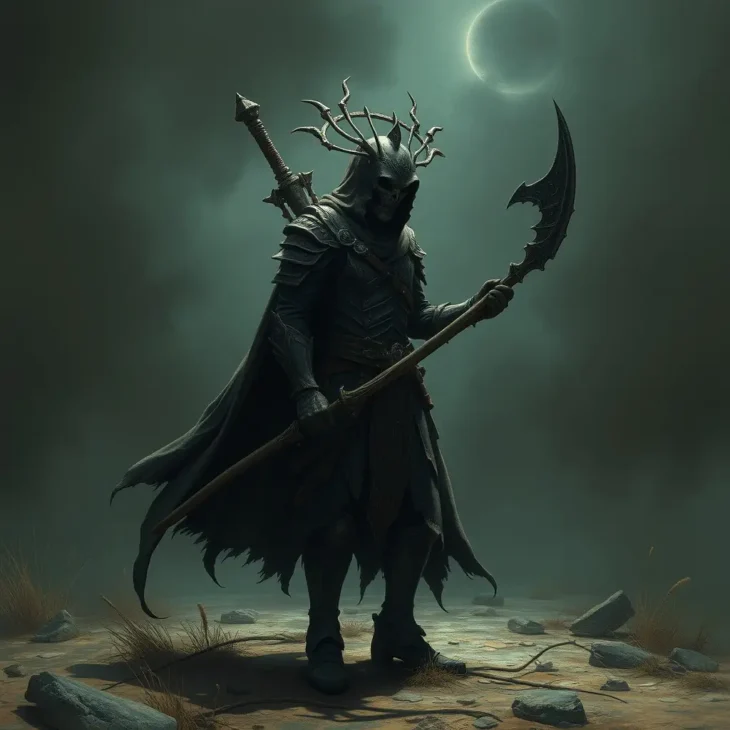Urban Legends: South Africa, India, Brazil, Russia

In Brazil, the legend of the Brazilian Lady in White, or Dama Branca, is linked to young white women’s violent deaths. These deaths often happened due to adultery, denial of sex, or abuse. This legend is just one of many fascinating stories that have shaped traditions in places like South Africa, India, Brazil, Russia, and Thailand.
These stories often tell of a scary figure called the “Sack Man” or “Bogeyman.” He kidnaps naughty children, filling generations with fear and wonder. From the White Lady ghost in European castles to South Africa’s Antjie Somers bogeyman, these tales are deeply rooted in their countries’ cultures.
This article dives into these tales, looking at their regional differences, historical roots, and lasting impacts. We also explore their surprising links to Christmas traditions in some areas. Get ready to be both amazed and a little scared as we delve into these urban legends from around the world.
Key Takeaways
- Urban legends from South Africa, India, Brazil, Russia, and Thailand often feature a terrifying figure known as the “Sack Man” or “Bogeyman”.
- These legendary characters have become deeply embedded in local folklore and traditions, shaping cultural narratives across diverse regions.
- The Brazilian Lady in White, or Dama Branca, is a well-known urban legend linked to the violent deaths of young women in Brazil.
- The White Lady ghost is a common figure in European folklore, haunting castles and associated with tragic stories of love, forced marriage, and suicide.
- Some of these urban legend characters, like the Sack Man, are also connected to Christmas traditions in certain countries, such as Zwarte Piet and Krampus.
The Sack Man: A Terrifying Folklore Figure
The “Sack Man” is a scary figure from folklore, like the bogeyman. He is seen as a menacing man with a sack on his back. He kidnaps naughty children, making kids all over the world very scared.
Regional Traditions of the Sack Man
In places like Spain, Portugal, and Italy, the Sack Man is known by different names. He is called “el Hombre del costal,” “el hombre del saco,” or “o homem do saco.” He plays the same role, scaring kids into behaving well.
The Sack Man in Iberia and Latin America
In Iberia and Latin America, the Sack Man is a big part of folklore. Parents use him to scare kids into being good. They say he’ll take naughty kids away.
Eastern Europe and the Caucasus Versions
In Eastern Europe and the Caucasus, the Sack Man is known by different names. In Armenia and Georgia, he’s called the “Bag Man.” In Hungary, he’s the “zsákos ember.” In Poland, he’s the “bebok” or “bobok.” These names show how widespread this scary figure is.
The Sack Man’s lasting place in folklore shows the power of stories. They shape our culture and teach values to kids. This mysterious figure still fascinates people all over the world.
Asian Sack Man Tales to Frighten Children
The “Sack Man” legend is not just for the West. It’s also found in Asia, used to scare kids who misbehave. In North India, kids are warned about “Bori Baba” or “Father Sack.” In Lebanon, “Abu i Kees” (meaning “The Man with a Bag”) roams the streets.
In Turkey, “Kharqyt” (also known as “Öcü,” “Böcü,” or “Torbalı”) is a sack-wearing man who kidnaps and eats naughty kids. Korea and Vietnam have their own versions, like “mangtae yeonggam” and “ông ba bị” or “ông kẹ.” In Sri Lanka, the “Goni Billa” or “sack kidnapper” scares Sinhalese kids.
| Region | Local Name | Description |
|---|---|---|
| North India | Bori Baba | Father Sack |
| Lebanon | Abu i Kees | The Man with a Bag |
| Turkey | Kharqyt, Öcü, Böcü, Torbalı | A man with a sack who kidnaps and eats or sells naughty children |
| Korea | mangtae yeonggam | Sack Man |
| Vietnam | ông ba bị, ông kẹ | Sack Man |
| Sri Lanka | Goni Billa | Sack kidnapper |
These sack man figures show how folklore is loved across Asia. From India to Lebanon, Turkey, Korea, Vietnam, and Sri Lanka. They remind us of the power of stories in shaping who we are and what we believe.
“The Sack Man is a figure that has captivated the imaginations of children and adults alike across the Asian continent. From the bustling streets of North India to the tranquil shores of Sri Lanka, these tales of a mysterious figure who preys on the misbehaving serve as a testament to the enduring power of folklore in shaping cultural identity.”
African Folklore: Antjie Somers, the Bogeyman
In South African folklore, “Antjie Somers” is a standout figure. This male entity, named after a female, captures naughty kids in a sack. This has scared many children in the Western Cape for generations.
The story of Antjie Somers comes from South Africa’s complex history. The nation’s past of slavery and persecution is woven into its folklore. The Bogeyman, once a slave, now punishes misbehaving kids to teach them fear and obedience.
What makes Antjie Somers unique is his cross-dressing. Despite being named after a female, he is a male figure. This mix of gender shows the diversity and adaptability of South African antjie somers, bogeyman, south africa, folklore traditions.
“The tales of Antjie Somers have been passed down through generations, instilling a sense of fear and wonder in the hearts of children across the Western Cape. This captivating Bogeyman figure serves as a reminder of the power of folklore to shape cultural identity and reflect the complex narratives that have defined South Africa’s history.”
The legend of Antjie Somers is a key part of African antjie somers, bogeyman, south africa, folklore traditions. His stories of capture and punishment, along with his gender-bending portrayal, show the lasting impact of storytelling. They shape the collective imagination of a people.
Urban Legends: South Africa, India, Brazil, Russia, Thailand
Urban legends are found all over the world. In places like South Africa, India, Brazil, Russia, and Thailand, these stories are part of local folklore. They shape the culture and beliefs of these communities.
In South Africa, the Joelma Building in São Paulo, Brazil, is said to be haunted. It happened after a fire in 1974. Also, the Chase Vault in Barbados is famous for its moving coffins. Australia has its own haunted spots, like the Ararat Lunatic Asylum.
In the Indian subcontinent, there are many myths and legends. For example, the Shore Temple in Tamil Nadu was submerged by a storm. The 2004 tsunami revealed two more temples in Mahabalipuram.
| Region | Notable Urban Legends |
|---|---|
| South Africa | Joelma Building (São Paulo, Brazil), Chase Vault (Barbados) |
| India | Shore Temple (Tamil Nadu), Submerged Temples (Mahabalipuram) |
| Brazil | Joelma Building (São Paulo) |
| Russia | No notable urban legends mentioned |
| Thailand | No notable urban legends mentioned |
In Indian folklore, there’s a story about the Amritam drops. They fell in Haridwar, Nashik, Ujjain, and Prayagraj. There’s also the legend of King Ravana and the Ram Setu bridge.
Urban legends fascinate people all over. They connect us across the world. From South Africa to India, Brazil, Russia, and Thailand, these stories show the power of imagination.
The Sack Man’s Association with Christmas Traditions
The “sack man” figure comes from ancient stories and is part of some Christmas traditions. In the Netherlands and Flanders, “Zwarte Piet” (Black Pete) is linked to Sinterklaas. Sinterklaas brings presents on December 5th. Zwarte Piets help Sinterklaas and, in some tales, they were once kidnapped children.
Zwarte Piet and Sinterklaas in the Netherlands
Sinterklaas, an old bishop, brings gifts to good kids on December 5th. He is joined by Zwarte Pieten, who have black faces and carry sacks. They take away naughty kids. This tradition has raised questions about racism, as Zwarte Pieten are seen as stereotypes.
Krampus: The Sack-Carrying Companion
In Alpine Europe, Krampus is like the “sack man.” He’s a horned, evil creature opposite to Santa. Krampus carries a sack or washtub to take away bad kids. This dark Christmas tradition is now popular, with Krampus parades in many cities.
Source Links
- White Lady
- Urban Legends — Harvard University Press
- 12 Japanese Urban Legends and its Scary Creatures
- African folklore – Page 4 – A Book of Creatures
- Demons – Page 2 – A Book of Creatures
- Traditional Japanese Masks | 18 Types and Their Stories
- Myths and Legends of Lake Kariba · Hideaways Africa
- List of reportedly haunted locations
- An Introduction to Myths and Legends in India
- The Incredible Buddha Boy
- Observance of Christmas by country
- Santa Claus Around the World: Global Christmas Traditions



